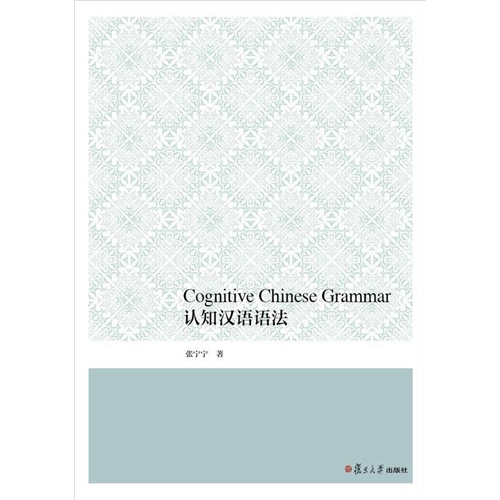
认知汉语语法

温馨提示:5折以下图书主要为出版社尾货,大部分为全新(有塑封/无塑封),个别图书品相8-9成新、切口有划线标记、光盘等附件不全详细品相说明>>
- ISBN:9787309114249
- 装帧:一般胶版纸
- 册数:暂无
- 重量:暂无
- 开本:32开
- 页数:392
- 出版时间:2015-05-01
- 条形码:9787309114249 ; 978-7-309-11424-9
本书特色
《cognitive chinese grammar认知汉语语法》协调了认知语言学中的隐喻、转喻、范畴化、概念整合、词汇压制、认知语法、认知语义学、认知词汇学等等理论,建立了一个适合全面分析自然语言现象(不仅仅是汉语现象)的理论框架,并将其运用于分析(部分)汉语语法现象。《cognitive chinese grammar认知汉语语法》企图说明:(1)汉语语法并不“特殊”,完全可以用认知和语言的一般规律来描写和解释;(2)汉语的句法结构并不象有些学者认为的那样“灵活”,而句法—词汇融合上的限制同样也可以用认知规律来解释;(3)一种语言现象背后往往存在好几种认知因素,“非此即彼”的结论存在很大风险,“综合”式的解释才符合语言和思维规律。
内容简介
《Cognitive Chinese Grammar认知汉语语法》协调了认知语言学中的隐喻、转喻、范畴化、概念整合、词汇压制、认知语法、认知语义学、认知词汇学等等理论,建立了一个适合全面分析自然语言现象(不仅仅是汉语现象)的理论框架,并将其运用于分析(部分)汉语语法现象。《Cognitive Chinese Grammar认知汉语语法》企图说明:(1)汉语语法并不“特殊”,完全可以用认知和语言的一般规律来描写和解释;(2)汉语的句法结构并不象有些学者认为的那样“灵活”,而句法—词汇融合上的限制同样也可以用认知规律来解释;(3)一种语言现象背后往往存在好几种认知因素,“非此即彼”的结论存在很大风险,“综合”式的解释才符合语言和思维规律。
目录
preface
chapter one introduction
chapter two cognitive chinese grammar: a framework
1.cognitive resources
2.a cognitive—linguistic perspective on grammar
3.academic labeling
4.implicit and explicit linguistic knowledge
chapter three instruments as objects
1.introduction
2.definition of instrument
3.constraints on instrument objects
4.summary
chapter four the unlikely objects of 吃(chī)
1.introduction
2.a classification of吃+object combinations
3.the semantic network of吃
4.the productivity of the 吃+object construction
5.summary and discussion
chapter five the bǎ(把)—construction
1.introduction
2.previous studies
3.an anatomy of the bǎ—construction
4.the semantic characteristics of the main verb
5.the semantic characteristics of the pre—posed object
6.the many faces of the result element
7.the semantic characteristics of the subject
8.anomalous instances of the bǎ—construction
9.the bǎ—construction and the shǐ(使)—construction in
comparison and contrast
10.summary and discussion
chapter six resultative constructions
1.introduction
2.conceptual motivations
3.the make—up of verb—result structures
4.the verb—copying resultative construction
5.the de(得)—resultative construction
6.directional lexemes as result elements
7.inversion in resultatives
8.summary
chapter seven the double—object construction
1.introduction: settling the dust
2.the double—object schema and its constructional meaning
3.the semantics of the verb
4.the curious case of the“np1+v+他+(numeral)np2”
template
5.pseudo—double—object structures
6.summary
chapter eight the existential construction
1.introduction: issues and non—issues
2.the chinese existential construction: an anatomy
3.the locative np
4.the predicate verb
5.the locatum np
6.the disappearance—emergence construction
7.summary and discussion
chapter nine nominal predicates
1.introduction
2.patterns with nominal predicates
3.cognitive operations behind nominal—predicate templates
4.“inherently predicative”nps and pattern(e)
5.nouns functioning as adjectives
6.summary and discussion
chapter ten the double—subject construction
1.introduction: a delimitation
2.aligning the base and the profile
3.other double—subject constructions
4.summary
chapter eleven the bèi(被)—construction
1.introduction
2.the bèi—construction,a sketch
3.the patient—subject
4.the nature of the agent np and the predicate
5.the newfangled bèi—schema
6.summary
chapter twelve conclusion and prospectus
references
-

世界尽头的咖啡馆
¥15.8¥45.0 -

蛤蟆先生去看心理医生
¥19.8¥38.0 -

《标点符号用法》解读
¥5.3¥15.0 -

咬文嚼字二百问
¥13.7¥32.0 -

从零开始的女性主义
¥25.0¥52.0 -

字海探源
¥23.4¥78.0 -

乡土中国
¥12.2¥26.0 -

与内心的恐惧对话:摆脱来自亲人的负能量
¥34.1¥48.0 -

从白大褂到病号服:探索医疗中的人性落差
¥17.2¥39.8 -

社会学:原来这么有趣有用
¥9.0¥36.0 -

始于极限:女性主义往复书简(八品)
¥33.6¥59.0 -

你能写出好故事-写作的诀窍.大脑的奥秘.认知的陷阱
¥13.5¥32.8 -

那一定是心理问题:科学识别身体和心理发出的求救信号
¥19.2¥52.0 -

理解生命
¥10.5¥32.8 -

焦虑心理学:不畏惧、不逃避,和压力做朋友
¥16.3¥38.0 -

中国人的精神
¥14.8¥29.0 -

记忆错觉-记忆如何影响了我们的感知.思维与心理
¥23.9¥39.8 -

上大演讲录(1922-1927卷)(九品)
¥14.0¥52.0 -

乌合之众:大众心理研究
¥11.0¥36.8 -

那时的大学
¥12.1¥28.0











